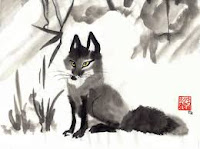Koans are stories, or questions, given to students and monks by their Masters to discipline them and to test their understanding of Zen. Zenists also use the koans to challenge each other and to test each other’s—as well as their own— ability. In ancient days it was the custom for monks to visit different Zen Buddhist monasteries and temples with the purpose of challenging the residing Master. This was sincere and rigorous practice. The koan literally means “public record.” Ko means public; an means record. Just as the reports, or case records, in courts of law are used as precedents in order to exercise and interpret the law, the koan is utilized to express the universality, or absoluteness, of Zen. The koan is not private or mystic in any sense. It is through the koan that the essence of Zen, the essence of life, is communicated. This is somewhat like love, which is experienced privately but, at the same time, has universality—anyone can experience it. Though universal, love is. communicated directly from one person to another, just as Zen is transmitted from mind to mind.In order to communicate love, words are often insufficient. Since love is life, it is immediate and direct, and the method of communication is very dynamic. Love may even be communicated by hitting, scolding, and other contrary expressions. Sometimes to express deep concern and love we say, “I don't love you.” Love gives and love takes away. Love does not have just one, static form. So in Zen, the truth of reality, the essence of life is
communicated dynamically. There are koans, “Khats” (deep sudden cries), and blows, all aimed at awakening the student. Negative methods are often more effective than the ordinary affirmative ways of teaching. There is no room or sentimentality because Zen deals with the essence of life and the truth of the universe. The koan is never solved by reason or by the intellect. Koans are solved only through living experience or by intuitive understanding. Today, many people intellectualize and conceptualize life and so become victims of concepts and intellect. Concepts create trouble in life because conceptualizations become confused with real things. Life is living, clear and simple. (Why can’t we become more simple and direct?) The koans point out the simplicity and directness of life and truth; therefore, reasoning and intellectual judgment are totally useless to solve koans.
Of course, to understand and appreciate koans fully, one should have some background in Chinese and Japanese culture and in Buddhism—the more one has, the easier the task will be. If one wishes to study further, there are excellent English translations of The Hekigan Roku, with commentary by Setcho and Engo, and the Mumonkan, with commentary by Mumon. If one wants to enjoy, appreciate, and live life fully, one must be aware of the truth of life. Ancient Chinese and Japanese Zen people had such an awareness, as is reflected in their approach to nature and human life. Man is, after all, only a small part of nature. Those ancient Zenists always harmonized and became one with nature. They never thought in terms of “conquering” nature. To see Chinese pictures and read Chinese poems is to discover that man always disappears into nature. Indeed, nature is frequently more compatible with man’s well-being than is human society—particularly when it is dominated by politicians and profiteers.
To illustrate this, there is a story about a Chinese Zen monk who lived in a tree. The governor of the district, named Hakurakuten, heard of this famous Zen monk and visited him one day. Seeing the monk perched high up in the tree, the governor said, “Living on the tree is quite dangerous; you might fall at any moment. Why don’t you live on the ground?” The monk replied, “Is it safe down there on the earth?” We can see the dangers of earthly life today more clearly than ever before. Many koans are difficult to understand because they treat the absolute, the essence of life, in such a simple yet symbolic way.
The koan deals with a dimension deeper than the world of the five senses. All of our knowledge is based on sensation, perception, conception, ideas, conscious thought, and the psychological subconscious mind. We are firmly attached to these areas of knowledge and tend to feel there is nothing outside them. But Zen deals with wisdom that transcends ordinary knowledge. And when one comes to understand the Zen realm of non-attachment, the factual world is seen in an entirely different light. All the troubles of life, without exception, are the result of attachment. Instead of clinging—or attaching—to things and conditions, one should understand the true, changing nature of the world and live freely within it.
One can become the master of life and of one’s world instead of a slave to both. That is the intention of Zen, and the koan, in trying to demonstrate the reality of life, is Zen’s most useful tool. After all, the purpose of studying a koan is not simply to understand it and be finished with it, but to live the koan, solving it each day.




